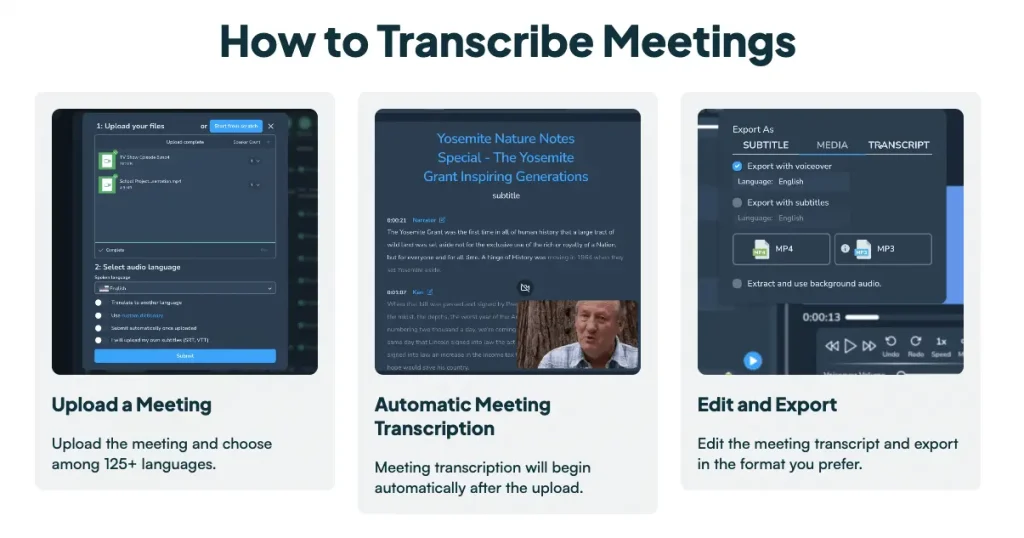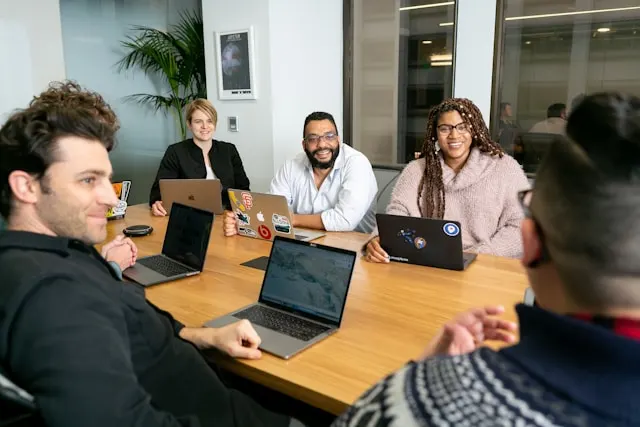How to Host an Introductory Meeting: Tips & Examples

An efficient introductory meeting is a seed, which will eventually bloom into successful interactions and partnerships. It will help people feel comfortable, emphasize open communication, and create a positive environment for future gatherings.
In this blog, we will:
- Explain what an introductory meeting is and its different types
- Highlight the benefits of introductory meetings
- Share a step-by-step guide on how to host successful introductory meetings
- Provide an introductory meeting agenda template and email example
Let’s get started.
What is an introductory meeting?
An introductory meeting is the initial formal gathering between individuals or parties, typically to set the foundation for future interactions. Whether personal or professional, it’s the first step to build a connection.

5 Types of Introductory Meetings
Introductory meetings come in different forms. Here are 5 main types, each with its own specific goals and considerations.
Introduction of New Team Member
Goal: Welcome and integrate the new member, introduce them to the team and the company culture.
Considerations: Prepare introductions, team bios, and an agenda that highlights company values and expectations.
Client Meeting
Goal: Explore a potential partnership, discuss client needs, and determine if your services are a good fit.
Considerations: Research the client’s business, prepare a tailored presentation, and be ready to answer questions about your expertise.
Investor Meeting
Goal: Secure funding for your business idea by presenting a compelling pitch.
Considerations: Be prepared to answer tough questions, and emphasize the potential for return on investment.

Sales Demo
Goal: Showcase the features and benefits of your product or service to a potential customer.
Considerations: Tailor your demo to the specific needs of the customer, highlight the value proposition, and be prepared to answer questions about pricing and implementation.
Introduction as a New Manager
Goal: Establish a connection with your new team and outline your leadership style.
Considerations: Share your vision for the team and create an open communication channel.
Benefits of an Introductory Meeting
Introductory meetings offer a range of benefits that can lay the foundation for success in future collaboration efforts. Let’s take a look at them.
- Build relationships: An introductory meeting allows people to get to know each other, helping create a sense of trust. By sharing stories and interests, people can feel more comfortable working together.
- Align goals: Introductory meetings clarify objectives and what’s expected of each person. This will get everyone on the same page from the start and avoid misunderstandings later on.
- Improve communication: The key to effective collaboration is to feel comfortable asking questions and sharing ideas. Introductory meetings can set the tone for open communication by providing a space for participants to express themselves.
- Make everyone feel welcome: An introductory meeting can break the ice, which is especially important for new team members. Having a casual and welcoming atmosphere can put everyone at ease.
- Uncover hidden opportunities: Introductory meetings can sometimes spark unexpected ideas. By bringing diverse perspectives together, you might discover innovative solutions that weren’t initially considered.
How to Host an Introductory Meeting
Now let’s move on to how you can host a successful introductory meeting, whether you’re going to introduce a new team member, yourself as a new manager, or your business to a potential customer. Feel free to embrace these actionable tips to make the most of this crucial initial step.
Before the Meeting
- Identify your objective. Are you introducing a new team member, presenting yourself as a new manager, or showcasing your business? Defining your goal is the first step in ensuring that the meeting is focused and productive.
- Research the attendees. Take a few minutes to learn more about key participants, particularly if it’s a client meeting. Knowing their potential interests can help personalize your introductions and discussions.
- Craft and share the meeting agenda. Allocate specific time slots for introductions and outline key topics to be covered. Send the agenda so people can come prepared with relevant questions and talking points.
- Prepare the meeting space. For in-person meetings, make sure the room is set up appropriately for the number of attendees. For virtual meetings, double-check your video and audio connection to avoid technical issues during the meeting.
- Practice makes perfect. Rehearsing your introductions and presentations can significantly boost your confidence and delivery. This will also allow you to refine your talking points, and anticipate any potential questions.

During the Meeting
- Make a strong start. Introduce yourself with a confident tone, and briefly share your role. If introducing a new team member, warmly welcome and encourage them to share their background and expertise.
- Follow the agenda. Use it as a guide to keep the discussion focused and ensure all planned topics are covered within the allocated time. Don’t dominate the conversation, and allow attendees to ask questions.
- Incorporate activities. Depending on the meeting purpose and size, you can have an icebreaker session, poll, or breakout room discussion. This will keep attendees engaged and foster participation.
- Use visuals. Tailor them to your audience’s level of understanding, and avoid complex elements that can overshadow your message. For larger groups, consider utilizing audience response systems or online whiteboards where attendees can contribute directly to the visuals.
- End with clarity. Before concluding, summarize the main points discussed and any key decisions made. Highlight next steps, including action items with their owners and deadlines.

After the Meeting
- Send a “thank you” email. You can go a step further by mentioning something specific you appreciated. For example, you can say “I especially enjoyed hearing your insights on [topic].”
- Seek feedback. If it’s a particularly important introductory meeting, you can consider sending a short survey to attendees. This will demonstrate your commitment to continuous improvement and can provide insights for future meetings.
- Stay connected. You can add participants to your professional network (like LinkedIn) depending on the context of the meeting and your comfort level. However, respect boundaries and don’t bombard contacts with messages.
- Maintain momentum. If the introductory meeting was the first step in an ongoing collaboration, schedule a follow-up meeting to discuss progress. That way you can address questions and keep the project moving forward.
- Share the meeting transcript and notes. While a transcript can capture the exact flow of the conversation, a meeting summary can provide a more concise overview of the key points. You can offer both to cater to different preferences.
Tip: You can easily get a meeting transcript with Maestra’s AI Meeting Transcript Generator. All you have to do is upload your meeting recording, and you will receive a polished and accurate transcript within seconds. Feel free to edit your document with the built-in text editor, and export it in the format you prefer. Also, Maestra comes with Zoom integration that allows users to effortlessly upload and transcribe Zoom meetings.

Introductory Meeting Agenda Template
Let’s assume you’re going to introduce a new team member to your colleagues. The following agenda template can help you conduct an effective introductory meeting while offering a smooth transition for the new member.
Meeting title: Welcome to the Team! Meet [New Team Member’s Name]
Meeting date and time: [Date] – [Time]
Meeting location: Physical location or online meeting link
List of meeting participants:
- Your name and title
- New team member’s name and title
- List of participants and their titles
Meeting objectives:
- Welcoming [New Team Member’s Name] to the team
- Introduce team members and explain team dynamics
- Address any questions
Meeting agenda:
- Welcome & Introductions
Each attendee will introduce themselves to welcome [New Team Member’s Name] to the team.
- About [New Team Member’s Name]
[New team member’s name] will share their professional background, experience, and optionally their interests outside of work.
- Team Overview & Dynamics
We will briefly explain the purpose of our team, our overall goals, team dynamics, and communication methods.
- Questions & Discussion
Open floor for the questions from both [New Team Member’s Name] and existing team members.
- Next Steps & Support
We will outline any onboarding plans for [New Team Member’s Name] and who they can reach out to for support.
- Meeting Close
We will summarize key takeaways.
*You can add extra agenda items based on your specific needs.
*You can add time slots to each agenda item.
*Consider incorporating an icebreaker activity or a team-building exercise to lighten the mood and promote interaction.

Introductory Meeting Email Example
What about the invitation email you will send prior to the meeting? Feel free to use the template below to announce the introduction of your new team member.
Subject line: Meet Our Newest Team Member, [New Team Member’s Name]! (Welcome & Info Session)
Hi everyone,
Join us in welcoming [New Team Member’s Name] to the team on [Date] at [Time].
Meeting location: [Online meeting link] or [Physical location]
We’ll get acquainted with introductions, hear from [New Team Member’s Name] about their background, get a team overview, and have time for questions. You can find the detailed meeting agenda attached.
See you there and let’s give [New Team Member’s Name] a warm welcome!
Best,
[Your name]
[Your title]
Frequently Asked Questions
What should I say in an introductory meeting?
A good introductory meeting strikes a balance between informing and engaging participants. If you’re introducing yourself, you can share a bit about your background, experience, and why you’re excited to be involved. If you’re introducing someone else, you can highlight their role and why they’re present. You can practice beforehand to deliver your introduction smoothly.
What questions can I ask in an introductory meeting?
Remember to tailor your questions to the specific situation. For example, if you’re introducing your business to a potential client, you can ask about their current pain points or desired outcomes. Those introducing a new team member can ask them what they’re looking forward to in their new role, or how they can be supported during this transition.
How do you title an introductory meeting?
An effective introductory meeting title is clear, concise, and informative. You can simply state the purpose of the meeting: Introduction to [Your Company Name], or focus on the value you bring: [Your Company Name] – How We Can Help You With [Their Need]. For informal team meetings, you can use a more casual tone and say: Meet the New Team Member – [Name].
How do you start an introductory meeting with a potential client?
Start with a warm greeting and a quick introduction of yourself. Thank them for their time and express your enthusiasm for meeting with them. Don’t jump into the sales pitch; first ask questions to uncover their goals and challenges. Then, focus on how your services or experience can solve their specific problems.
How do you prepare for an introductory meeting for a job?
First, research the company and meeting attendees. Prepare a short introduction highlighting your skills and have questions for them. Don’t forget to dress appropriately, and project confidence during the meeting for a positive first impression.
Summary
This blog covered what an introductory meeting is as well as its benefits and different types. Most importantly, it shared actionable tips on how to run a successful introductory meeting, and provided an agenda template and email sample for implementation.
These meetings are now more important than ever in the age of technology and remote work. They have the power to bridge the physical gap and build trust, which are crucial for collaboration. By adopting the tips and templates outlined in this blog, you can ensure your introductory meeting blossoms into a long-lasting partnership.
